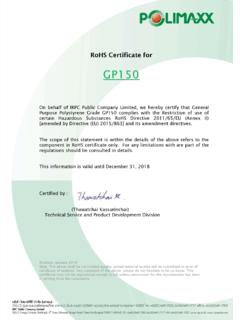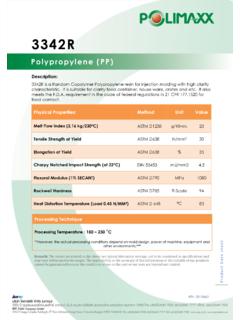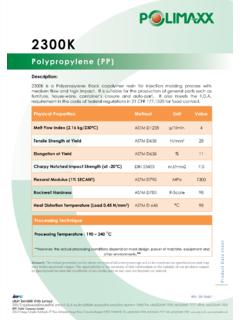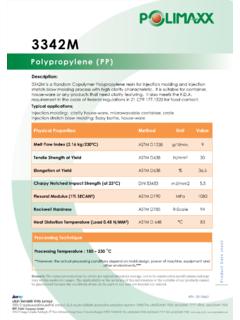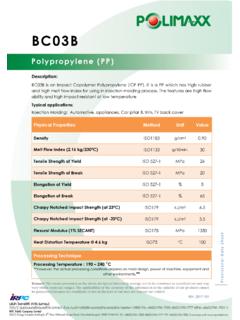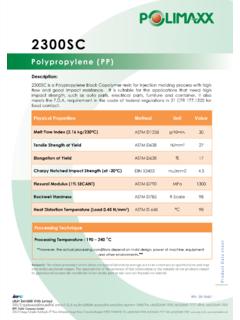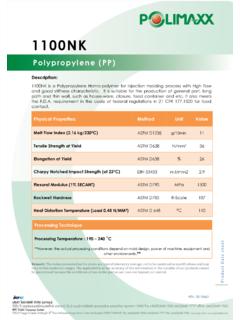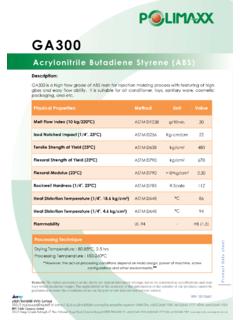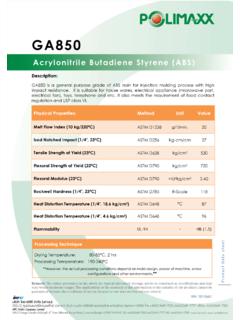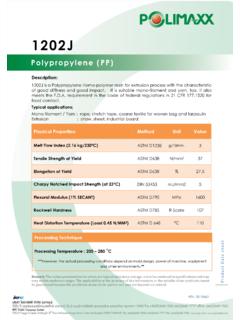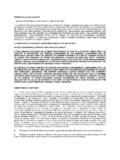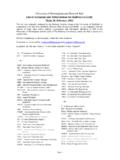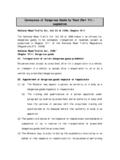Transcription of In Accordance with 4 - IRPC
1 D a t e o f R e v i s i o n 15 Ja n u a r y 2 0 13 1 S A F E T Y D A T A S H E E T In Accordance with 4th revised edition of GHS Section 1 Identification Product Name : GA850 Product Type : General Purpose Product Description : ABS, ABS Resin Chemical Name : Acrylonitrile Butadiene Styrene Chemical Formula : (C3 -H3 -N)n (C4 H6) n(C8 H8) n Chemical Family : Thermoplastic Polymer Product Use : Can be used to produce extrusion molded articles for commercial or industrial products.
2 Manufacturer : IRPC Public Company Limited. 299 Moo 5 Sukhumvit Road, Amphur Muang Rayong Thailand Emergency Call : +66(0)38 802560 Website : , Section 2 Hazards Identification Regulation (EC) No 1272/2008: This product is not classified as dangerous according to Regulation (EC) No 1272/2008. Directive 67/548/EEC : This product is not classified as dangerous according to EU Directive 67/548/EEC. Regulation (EC) No 19072006 : This product is complied REACH Regulation (EC) No 1907/2006.
3 GHS : Not classified Label elements : Not applicable Other hazards : Not applicable Section 3 Composition / Information on Ingredients Chemical Name CAS Number EC Number Percent weight Acrylonitrile Butadiene Styrene Copolymer 9003-56-9 Polymer 97-99 Styrene 100-42-5 202-851-5 < Product contains high molecular weight polymers, and is not expected to be chemically active under normal conditions of handling and processing. Section 4 First-aid Measures General information : Clothing and shoes must be immediately removed, decontaminated Skin Exposure : In case of skin contact with hot polymer immediately immerse in or flush with clean, cold water.
4 If irritation develops, seek medical attention. Eyes Exposure : Flush with water for at least 20 minutes. Seek medical attention if irritation persists Inhalation : Remove person to fresh air. Assist in breathing if necessary. Seek medical attention. Ingestion : Seek medical attention if a significant amount is swallowed D a t e o f R e v i s i o n 15 Ja n u a r y 2 0 13 2 Section 5 Fire-fighting Measures Suitable extinguishing agents: Dry chemicals, foam, water, carbon dioxide and halon. Do not use water jets for large fires.
5 Hazards during fire-fighting : Carbon monoxide, carbon dioxide, hydrogen cyanide. Protective equipment : Wear self-contained respiratory protective device. Section 6 Accidental Release Measures Personal precautions : Avoid inhalation. Environmental precautions : Discharge into the environment must be avoided. Cleanup: STEPS TO BE TAKEN IN CASE MATERIAL IS RELEASED OR SPILLED: Sweep/shovel up or spray with water and collect in a suitable container. Allow molten material to solidify before disposal.
6 Avoid production of dust. Section 7 Handling and Storage Handling : Do not handle material without proper protective equipment. Provide adequate ventilation. Maintain good housekeeping in work areas. Storage conditions : Store in a cool, dry place in the original container when possible. Store below 50 C. Keep away from moisture, excessive heat and sources of ignition. Do not place in direct sunlight. Section 8 Exposure Controls / Personal Protection Exposure limits Component Name Reference TWA STEL ppm mg/m3 ppm mg/m3 Styrene OSHA PEL* 100 - - - ACGIH TLV 20 - 40 - *OSHA PEL: Acceptable ceiling concentration (ACC) 200 ppm, maximum concentration above ACC 600 ppm Exposure control : Ventilation, enclosures, or other controls may be needed to keep airborne contaminates below exposure limits.
7 Personal protective equipment Respiratory protection : Wear respiratory protection if ventilation is inadequate. Breathing protection device if dust is formed. Eye protection : Chemical workers goggles recommended. Protective clothing : Gloves required when handling hot material. In case of fire, wear MSHA/NIOSH approved self-contained breathing apparatus or equivalent and full protective gear. Ventilation : Provide adequate ventilation when processing material at elevated temperatures.
8 Other protective equipment: Section 9 Physical and Chemical Properties Physical State : Solid Form Odor and Appearance : Plastic pellets in natural or compounded color with characteristic odor. Softening Point : > 100 C D a t e o f R e v i s i o n 15 Ja n u a r y 2 0 13 3 Specific Gravity : (Water =1) Percent Volatile (Vol %) : Nil Solubility in water : Insoluble Solubility (Qualitative) : Soluble in polar solvents Section 10 Stability and Reactivity Stability : Stable Condition to Avoid : Avoid temperatures above 300 C.
9 Material to Avoid : Avoid solvents and oxidizing agents . Dangerous decomposition: Carbon monoxide, carbon dioxide, styrene, acrylonitrile, hydrocarbon, cyanide. Section 11 Toxicological Information Acute Toxicity Chemical name Route Species Acute Toxic Value Styrene Oral Rat LD50 5000 mg/kg Inhalation Rat - Irritating/corrosive effects Eye Irritation : Prolonged contact can causes eye irritation Skin Irritation : Prolonged contact can cause skin irritation Respiratory Irritation : May cause allergic respiratory response.
10 Ingestion Irritation : Swallowing larger amounts may cause injury Section 12 Ecological Information Toxicity : No relevant studies identified. Persistence and degradability : The product is not easily biodegradable. Bio-accumulative potential : Insoluble in water. Not expected to be bioaccumulative. Mobility in soil : No relevant studies identified. Other adverse effects : Not expected to pose a significant ecological hazard. Section 13 Disposal Considerations Disposal methods: Transfer to an approved disposal area in Accordance with national, state and local regulations.
